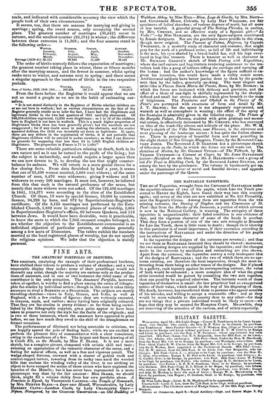FINE ARTS.
THE AMATEURS' PORTFOLIO OF SKETCHES.
TEM amateurs, emulating the example of their professional brethren, have clubbed their talents to produce a volume of sketches ; and a very respectable display they make: some of their pencillings would not discredit any artist, though the majority are curious only as the produc- tions of amateurs, and in one or two instances the titled name of the contributor is the only attraction. The Amateurs' Portfolio, however, taken altogether, is worthy to find a place among the series of lithogra- phic fac-similes by individual artists ; though in this case it takes thirty amateurs to rival a ROBERTS or a STANFIELD. The subjects are mostly travelling-sketches— views in Italy, Greece, and India, as well as England, with a few studies of figures: they are variously executed, in crayons, sepia, and outline; many having been originally coloured. That they are fac-similes is pretty evident : so far from being embel- lished by the lithographic copyists, great pains appear to have been taken to preserve not only the style but the faults of the originals ; and in two or three instances, where the amateurs have appeared in print before, we see how much they owed to the skill of the draughtsman on former occasions.
The performances of dilettanti not being amenable to criticism, we are happily spared the pain of finding fault; while we are enabled to perform the pleasant duty of commendation with a clear conscience, owing to the excellence of a few. The largest and finest drawing of all is Castle Elz, on the Moselle, by Miss F. BLAKE. It is not a mere sketch, but a complete picture, composed with artistic skill and taste ; evincing an appreciation of the romantic character of the scene, and a feeling for natural effects, as well as a free and vigorous pencil. The wedge-shaped fortress, crowned with a cluster of gabled roofs and conical-topped turrets, towering from its rocky base amid the wooded hills that enclose the winding valley of the river, is too striking an object to have escaped the notice of those artists who have explored the beauties of the Moselle; but it has never been represented in a more picturesque way than by the fair amateur : Miss BLAKE, we should think, might fill a volume richly from her own portfolio alone. A Fountain in Eyestb, by ViSe0UnteSS CANNING—the Temple of Soinnauth, by Mrs. HUNTER BLAIR—a Lane near Hewell, Worcestershire, by Lady HARR/ET ei-nrE—Lantbron Castle, by Lady CHARLOTTE GREY- NOtam Novogorod, by the Countess Gaosvation—an Old Building at Waltham Abbey, by Miss HILL—Riva, Logo di Garda, by Mrs. MOTT- and Government House, Calcutta, by Lady HAY WILLIAMS, are fair specimens of ladies' sketches ; of various degrees of merit, but all more or less tasteful. A graceful group of The Setting Pleiades, in outline, by Mrs. CHENEY, and an effective study of a Spanish girl—" Le Voila ! "—by Miss laworrrer, are the only figure-subjects contributed by female designers. Nor are the gentlemen more prolific in this class, though more original. The Peasant of Palma, Majorca, by Captain TWOPENNY, is a masterly study of character and costume, that might pass for the work of a professed artist ; so full of life and individuality is the man, his eyes shaded by a broad-leafed hat, and his legs enve- loped in bag-like trousers. There is humour as well as character in Mr. RICHARD GREENE'S sketch of Irish Posting with Expedition; where the turf-cutters and bog-trotters rendering assistance to the tra- vellers look like a gang of robbers rifling the carriage and carrying off the horses : had the author's knowledge of the figure sufficed to ex- press his intention, this would have made a richly comic scene. Architectural subjects have better justice done to them by the gentle- men than by the ladies, generally speaking. The most elegant and artist-like is Piazza Santa Maria del Pianto, Rome, by Mr. RUSKIN; in which the forms are indicated with delicacy and precision, and the effect of a blaze of sun-light is skilfully represented by the sharply- defined and small but strong shadows, which give breadth to the main of brightness. The Fountains and Obelisk in the Piazza of St. Peter's are portrayed with exactness of form and detail by Mr. J. T. SELWIN ; but the space is not adequately represented, and warmth as well as atmosphere is wanting : the effect of the spray of the fountains is admirably given in the lithotint copy. The Prison qf the Bargello Palace, Florence, studded with grim gratings and memo- rial-tablets, is effectively delineated by Mr. CHENEY, who has conveyed an idea of the tomb-like silence and solitude of the place. Mr. W. H. WEST'S sketch of the Villa Strozzi, near Florence, is the cleverest and most pleasing of the landscape scenes: it has quite the Italian charac- ter. There is perception of beautiful form and neat pencilling in the slight sketch of San Giorgio Maggiore, Venice, by the Reverend Cu,. VERT JONES. The Reverend J. D. GLENN IE has a picturesque sketch of Oberstein on the Nahe, in which the forms are well made out. The sketches of Mistra, by Mr. GEORGE VI-wen—of The Tolbooth, by Mg. VERNON HTTERSON—a Convent at Capri, by Mr. JOHN DAVENPORT junior—Hartford on the Ooze, by Mr. J. HEATHCOTE—and a group of old Fir Trees in Blickling Park, by the Reverend JAMES BULWER, are among the best by the gentlemen. The volume is handsomely got up. with an illuminated cover of novel and fanciful device ; and appears under the patronage of the Queen.


























 Previous page
Previous page